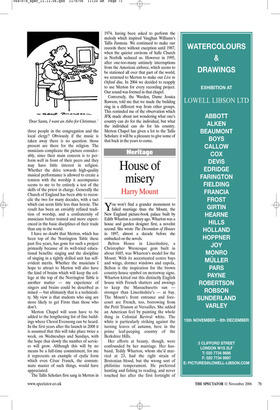House of misery
Harry Mount
You won’t find a grander monument to failed marriage than the Mount, the New England picture-book palace built by Edith Wharton a century ago. Wharton was a house and garden designer first, a novelist second. She wrote The Decoration of Houses in 1897, almost a decade before she embarked on the novels.
Belton House in Lincolnshire, a Christopher Wrenesque gem built in about 1685, was Wharton’s model for the Mount. With its accentuated centre bays and wings, dormer windows and cupola, Belton is the inspiration for the brown country-house symbol on motorway signs. Wharton kitted out this distinctly English house with French shutters and awnings to keep the Massachusetts sun stronger than Lincolnshire’s — at bay. The Mount’s front entrance and forecourt are French, too, borrowing from the Petit Trianon at Versailles. She added an American feel by painting the whole thing in Colonial Revival white. The white is particularly striking against the turning leaves of autumn, here in the prime leaf-peeping country of the Berkshire Hills.
Her efforts at beauty, though, were confounded by her marriage. Her husband, Teddy Wharton, whom she’d married at 23, had the right strain of Bostonian blood, but the wrong sort of philistine temperament. He preferred hunting and fishing to reading, and never touched her after the first fortnight of married life. Thought now to have suffered from bipolar disorder, he verbally abused his wife, while embezzling money from her trust fund and spending it on a Boston house for his mistress.
The final straw was when he sold the Mount without her permission while she was crossing the Atlantic in 1911. She never again saw the house she had designed, or her garden ‘rooms’ — a walled, sunken giardino secreto connected to a flower garden and rock garden by a lime walk — all planted 30 years before Vita Sackville-West began work on Sissinghurst. In 1937, Wharton died in France aged 75.
It’s no coincidence that the Mount, where Wharton wrote her first great novel, The House of Mirth (1905), became a house of misery. Misery was the grit in Wharton’s oyster; the better fitted-out the oyster shell, the deeper the misery. The House of Mirth, like many of her books, is about a woman torn between marrying for love and marrying for status. Like Wharton, her heroines and heroes — Lily Bart in The House of Mirth, Undine Spragg in The Custom of the Country, and Newland Archer in The Age of Innocence — went for status, to their cost. And, like her heroines and heroes, Wharton never found lasting love. The closest she came was with a philandering American journalist, Morton Fullerton, when she was 45.
He began their affair by giving her a cutting of witch-hazel. Wharton understood what he meant by it; as a gardener, she knew it was a late-blooming plant. For the first time since her disastrous wedding more than 20 years earlier, she embarked on a sexual relationship. She wrote about her passion, awakened in the Charing Cross Hotel, in ‘Terminus’, a poem sent to Fullerton: ‘Wonderful was the long secret night you gave me, my Lover,/ Palm to palm, breast to breast in the gloom ... you helped me to loosen my dress,/ And the shadow-mouths melted to one, like sea-birds that meet in a wave’. The caddish Fullerton dumped her and she lived on alone in Paris, but happy with her increasing success — The Age of Innocence won a Pulitzer Prize in 1921; in 1923 she was the first woman to receive an honorary doctorate from Yale.
The Mount led a battered existence in later life, as home to, among others, a theatre company and a girls’ school. The young ladies of Foxhollow School trimmed the flames of their Bunsen burners in Mrs Wharton’s old kitchen. Now owned by a charity, the Mount is almost fully restored. And it has just seen the return of its greatest jewel, Edith Wharton’s 2,700-volume library. Books were her lifeline: even in the darkest days with Teddy Wharton, she was awake at six a.m., spending hours in bed, reading and writing.
On her death, she left her library to her godson, Colin Clark, brother of Alan and son of her old art-historian friend, Kenneth Clark. Colin Clark flogged the library in 1983. Thanks to the efforts of the Yorkshire dealer George Ramsden, the library was kept together and added to for more than 20 years, before being bought for the Mount for £1.5 million this year. Her books are back, assembled in the library with its views opening out over her beloved garden, across Laurel Lake to the thickly wooded slopes of Mount Bonaparte.
Her childhood copy of Alice’s Adventures in Wonderland, the 1865 first American edition, signed books from her old friends, Henry James and Teddy Roosevelt (‘... from an American American!’ — a dig at her Parisian exile). They’re all there — little episodes of contentment, as books should be, punctuating a life that was too often sad in surroundings so designed for happiness.
The Mount, Lenox, Massachusetts, is open from May to October, 9 a.m.–5 p.m., tel: 001 413 637 1899. Harry Mount’s Amo, Amas, Amat and All That: How to Become a Latin Lover is published by Short Books (£12.99).



































































































 Previous page
Previous page